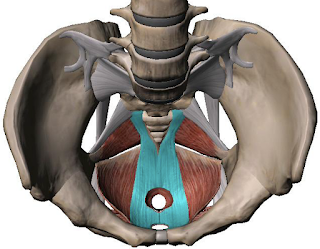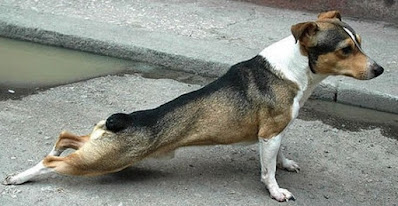II.46 Posture (asana) must have the two qualities of firmness and ease.
II.47 Posture (asana) is then when effort ceases and meditation on infinity occurs.
The Yoga Sutra of Patanjali, translation by Gregor Maehle
It's very important when practicing asana* in earnest to NOT damage the lower back with multiple repetitions of upward facing dog (urdhva mukha svanasana). This asana is extremely useful. Among other benefits it builds upper back strength required for improved posture and mobility. However if not anchored well it becomes a shortened inhale and cringing expression that we just want to pass through as quickly as possible.
 |
| bothendsofthelead.com.au |
To make this asana into a therapy tool, begin with the root of your spine.
There is a muscle (pubococcygeus) whose main action is to move the coccyx (tailbone) toward the pubic bone (the lowest bone on the front of the body). When this muscle is active and a continuous flow of breath cycles ensue, the lower spine is able to open and pressure melts away from the lower back, cascading release elsewhere along the spine and down the legs. This is one of the actions that activates the elusive Mula Bandha and can be attended to in every asana.
So, you think, this little 3 to 4-inch muscle is really the key to my back health? It's a good start. When the one little connector between the tail and pubic bones remains active we can find other deep pelvic muscles to support the effort of releasing compression. Originating the flow of breath through the pelvic base activates a deeper spinal support system. I surmise this is the foundation of "the core."
 |
| pubococcygeus in blue easynotecards.com |
In finding the upward facing dog, which is initiated with an inhalation, if we begin the movement deliberately bringing the tailbone toward the front of the body, the breath travels up an inner pathway. This long, concave inner space can be tracked from the lowest point of the torso through all the abdominal zones, the back of the lower ribs (hello, Kidneys) and into the middle rib cage. This is more easily experienced if the balls of the feet and knees are down on the mat.
With the straightening of the knees our upper leg bone seems to become part of the back. The muscles that adduct and extend the legs (bring the legs toward midline and away from the front, respectively) seem to merge with the strong back muscles (erector spinae), and air goes effortlessly into the lungs from the bottom up. This is the metaphorical rope connecting the anchor to the ship. I've had the experience of becoming a tadpole at this point.
The last layer of muscular support come from the feet, aka. The Anchor. The foot position in a conventional upward facing dog is top side down. Actively pressing the toe knuckles into the mat, as if pulling on a grounded anchor, stimulates a muscular chain all the way through those adducted and extended thighs into the posterior pelvic floor. A quick synaptic impulse invigorates the pubococcygeus on the return current and the above mentioned breath cavern is fueled from below. In this way the entire lower body creates a deeply supported structure for the upper chest to stretch itself against.
 |
| No legs, only tail. https://www.frogpets.com/ |
After all that concentration on the inhale, it's very important to keep this connection in the transition to the downward facing dog. Many practitioners will jump their feet into dorsiflexion (the balls of the feet connect to the mat), and very deliberately curl the the tailbone to initiate the counter-stretch into "the recovery position," a nickname for downward facing dog.
As a beginner, at the start of the exhale try putting the knees down again. Reposition the feet so the balls are down and aim the heels toward the mat. This reinforces the muscular chain that has created your internal cavern of breath. Then use the arms to push that wide open lower back, diaphragm and rib cage into an inversion. Dropping in the fully relaxed upper chest and its extension, the neck, is the juicy end of this exhale. And yay! You now get 4 more full breath cycles to explore the amazing internal support structure you have just created (if you are doing Ashtanga Vinyasa, that is).
I hope this deeper look into the pelvic floor (and below) has sparked curiosity. This may not be the answer to your issues with upward facing dog, but it is an invitation to put more awareness onto the possibility of a working relationship. To paraphrase Sage Patanjali's notes on asana, a purpose of the physical practice to attain durable and pleasant positions in which we can rest all effort and meditate on infinity. The codifier of the Ashtanga Vinyasa series seems to have believed that the flow created through deliberate sequencing of actions with the breath (also known as vinyasa) will do this.
Wishing everyone a productive, inspired practice, whatever it may be!
Christian
* I cannot bring myself to equate the words "yoga" and asana (postures). There is far more to the picture of yoga than the postures. I am among the many who have transitioned into this path through asana practice
 |
| puppytoob.com |